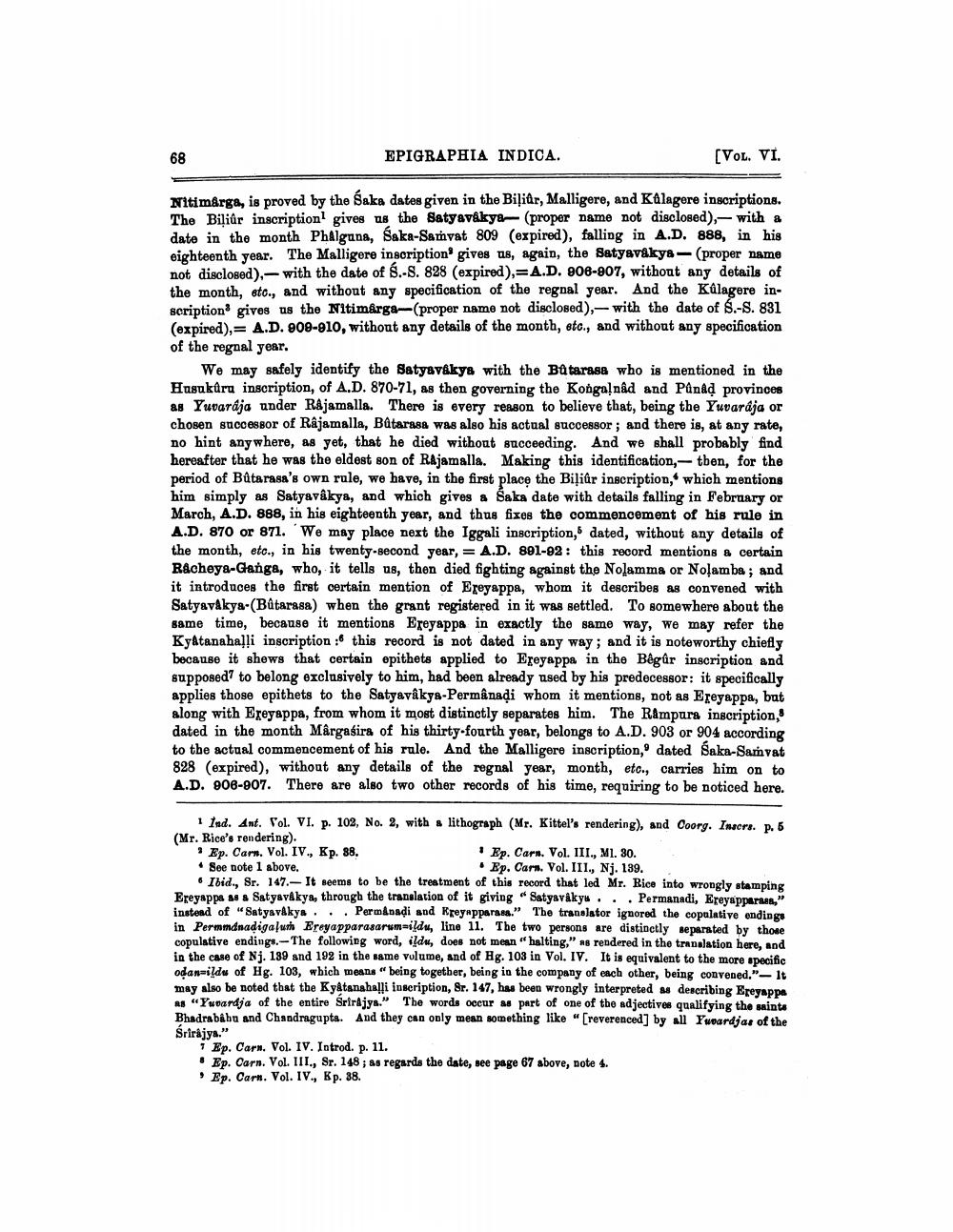________________
EPIGRAPHIA INDICA.
(VOL. VI.
Nitimarga, is proved by the Saka dates given in the Biļidr, Malligere, and Kalagere inscriptions. The Biliúr inscription gives us the Satyaváky-- (proper name not disclosed), - with a date in the month Phalguna, Saka-Samvat 809 (expired), falling in A.D. 888, in his eighteenth year. The Malligere inscription gives us, again, the Satyaváky8 - (proper name not disclosed), - with the date of $.-S. 828 (expired),=A.D. 906-807, without any details of the month, etc., and without any specification of the regnal year. And the Kûlagere inscription gives us the Nitimarga-(proper name not disclosed), with the date of S.-S. 831 (expired),= A.D. 009-910, without any details of the month, etc., and without any specification of the regnal year.
We may safely identify the Satyavákys with the Batarass who is mentioned in the Husukūru inscription, of A.D. 870-71, as then governing the Konga!nad and Panad provinces as Yuvarája under Råjamalla. There is every reason to believe that, being the Yuvarája or chosen successor of Rajamalla, Batarasa was also his actual successor ; and there is, at any rate, no hint anywhere, as yet, that he died without succeeding. And we shall probably find hereafter that he was the eldest son of Rajamalla. Making this identification,- tben, for the period of Batarasa's own rule, we have, in the first place the Biļiar inscription, which mentions him simply as Satyavákya, and which gives a Saka date with details falling in February or March, A.D. 888, in his eighteenth year, and thus fixes the commencement of his rule in A.D. 870 or 871. We may place next the Iggali inscription, dated, without any details of the month, etc., in his twenty-second year, = A.D. 891-92: this record mentions & certain Racheya-Ganga, who, it tells us, then died fighting against the Nolamma or Nolamba; and it introduces the first certain mention of Ereyappa, whom it describes as convened with Satyavákya-(Batarasa) when the grant registered in it was settled. To somewhere about the same time, because it mentions Ereyappa in exactly the same way, we may refer the Kyatanahalli inscription : this record is not dated in any way, and it is noteworthy chiefly because it shows that certain epithets applied to Ereyappa in the Begur inscription and supposed to belong exclusively to him, had been already used by his predecessor: it specifically applies those epithets to the Satyavákya-Permânadi whom it mentions, not as Ereyappa, bat along with Ereyappa, from whom it most distinctly separates him. The Rampura inscription, dated in the month Mârgasira of his thirty-fourth year, belongs to A.D. 903 or 904 according to the actual commencement of his rule. And the Malligere inscription, dated Saka-Samvat 828 (expired), without any details of the regnal year, month, etc., carries him on to A.D. 906-907. There are also two other records of his time, requiring to be noticed here.
1 Ind. Ant. Vol. VI. p. 102, No. 2, with a lithograph (Mr. Kittel's rendering), and Coorg. Inscrs. p. 6 (Mr. Rice's rendering). Ep. Carn. Vol. IV., Kp. 88.
Ep. Carn. Vol. III., M1. 30. . See note 1 above.
Ep. Cam. Vol. II1., Nj. 139. 6 Ibid., Sr. 147.-It seems to be the treatment of this record that led Mr. Rice into wrongly stamping Ereyappa as a Satyavákya, through the translation of it giving " Satyavákyu ... Permanadi, Ereyapparaan," instead of "Satyavákya ... Permånadi and Freyapparasa." The translator ignored the copulative endings in Permmdnadigalurh Ereyapparasarum=ildu, line 11. The two persons are distinctly separated by those copulative endings. The following word, ildu, does not mean "halting," as rendered in the translation here, and in the case of Nj. 189 and 192 in the same volume, and of Hg. 108 in Vol. IV. It is equivalent to the more specific odan-ilds of Hg. 103, which means "being together, being in the company of each other, being convened." - It may also be noted that the Kytanahalli inscription, Sr. 147, has been wrongly interpreted as describing Ereyappa AB "Yuvardja of the entire Srirajya." The words occur as part of one of the adjectives qualifying the saints Bhadrababu and Chandragupta. And they can only mean something like "[reverenced] by all Ywardjas of the Srirajya."
1 Ep. Carn. Vol. IV. Introd. p. 11. . Ep. Carn. Vol. III., Sr. 148; as regards the date, see page 67 above, note 4.
Ep. Carh. Vol. IV., Bp. 38.




